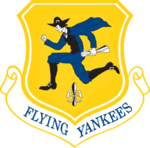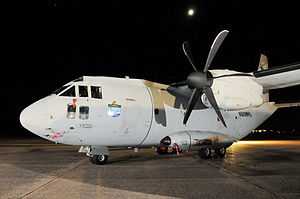Bradley Air National Guard Base
Bradley Air National Guard Base | |
|---|---|
| Part of Connecticut Air National Guard (CT ANG) | |
| Located near: Windsor Locks, Connecticut | |
|
A C-27J Spartan is shown on the ramp during a familiarization visit to the Bradley Air National Guard Base | |
 Bradley ANGB Location of Bradley Air National Guard Base, Connecticut | |
| Coordinates | 41°56′20″N 072°41′0″W / 41.93889°N 72.68333°W |
| Site information | |
| Controlled by |
|
| Site history | |
| Built | 1940 |
| In use | 1942-Present |
| Garrison information | |
| Garrison |
 103d Airlift Wing |
| Airfield information | |||||||||||||||||||
|---|---|---|---|---|---|---|---|---|---|---|---|---|---|---|---|---|---|---|---|
| IATA: BDL – ICAO: KBDL – FAA LID: BDL | |||||||||||||||||||
| Summary | |||||||||||||||||||
| Elevation AMSL | 173 ft / 53 m | ||||||||||||||||||
| Website | www.103aw.ang.af.mil | ||||||||||||||||||
| Runways | |||||||||||||||||||
| |||||||||||||||||||
Bradley Air National Guard Base is the home base of the Connecticut Air National Guard 103d Airlift Wing.
Overview
The 103rd Airlift Wing is located at the Bradley Air National Guard Base, located approximately 20 miles north of Hartford in northern Connecticut. The base is home to the 1000 personnel and equipment that make up the 103rd Fighter Wing. The nearby airfield is shared between Bradley International Airport and the 103rd Airlift Wing located at the Bradley Air National Guard Base.
The Flying Yankees received C-21 transport aircraft in 2007 and began flying airlift missions October 1, 2007. At the same time, the wing supported these separate aircraft missions, it began operation of the Centralized Intermediate Repair Facility - TF-34 shipping its first engine November 3, 2007. The wing formally became the 103rd Airlift Wing, April 1, 2008.
History
Bradley has its origins in the 1940 acquisition of 1,700 acres (690 ha) of land in Windsor Locks by the State of Connecticut. In 1941 this land was turned over to the U.S. Army, as the country began its preparations for the impending war.[1]
Soon after its establishment, the airfield at Windsor Locks suffered its first fatality. Among those serving there was 24-year-old Lt. Eugene M. Bradley of Antlers, Oklahoma, assigned to the 64th Pursuit Squadron. While piloting in a dogfight training drill, Lt. Bradley's P-40 crashed on August 21, 1941. Following his funeral in Hartford, Lt. Bradley's remains were interred at San Antonio National Cemetery in Texas.

Following a groundswell of sentiment in favor of naming the Windsor Locks airfield in Lt. Bradley's honor, the airfield became Army Air Base, Bradley Field, Connecticut on January 20, 1942. In 2009, a team led by the Connecticut state archaeologist used ground-penetrating radar to pinpoint Lt. Bradley's crash location under the end of current Runway 33.[2][3][4]
Bradley Field was used by the First Air Force primarily as a group training airfield for single-engine P-47 Thunderbolt fighter groups, which obtained their new aircraft from the Republic Aviation production plant on Long Island prior to their deployment to overseas combat theaters.
U.S. Army Air Force units known to have trained at Bradley:
- 326th Fighter Group, September–November 1942
- 348th Fighter Group, October 1942
- 352d Fighter Group, October–November 1942
- 58th Fighter Group, March–April 1943
- 362d Fighter Group, June–August 1943
- 370th Fighter Group, January 1944
- 402d Fighter Group, February–April 1944
- 452d Fighter Squadron (P-47 Replacement pilot training)
- 540th Fighter Squadron (P-47 Replacement pilot training)
- 489th Bombardment Group (Heavy)**, December 1944
- 319th Bombardment Group (Medium)**, January–February 1945
- Note: **Combat units redeployed from Europe, turned in aircraft at Bradley then were transferred to Second Air Force transition schools in the Midwest for B-29 Superfortress training prior to deployment to Twentieth Air Force in the Western Pacific.
Other units assigned to Bradley:
- 1st Photographic Squadron, December 1941 – January 1944
- 9th Photographic Squadron, March–April 1942
- 19th Reconnaissance Squadron (Long Range), September 1943 – January 1944
- 16th Reconnaissance Squadron (Special), November–December 1944
- Assigned to 73d Observation (later Reconnaissance Group). Based at Bradley but deployed numerous times to overseas locations.
The airfield was deactivated in March 1945. Following the end of World War II, control of the airfield was transferred to the State of Connecticut in 1946.
References
![]() This article incorporates public domain material from websites or documents of the Air Force Historical Research Agency.
This article incorporates public domain material from websites or documents of the Air Force Historical Research Agency.
- ↑ "Media Kit Fact Sheet". Bradley International Airport. Retrieved October 9, 2010.
- ↑ Marks, Paul (May 28, 2006). "Archaeological Sleuths Hunt For Site Of Bradley Airport Namesake's Fatal Crash". Hartford Courant. Retrieved November 14, 2011.
Bradley's fatal accident occurred during a simulated aerial dogfight with Frank Mears, commander of the 64th Pursuit Squadron. The plane Bradley was flying spun out of control as he went into a sharp turn at about 5,000 feet. Stunned witnesses saw the plane spiral slowly into a grove of trees. Soon a column of smoke arose. They theorize that the young pilot blacked out from the gravitational forces felt during such a sharp aerial turn.
- ↑ "Crash site of Bradley Airport's namesake pinpointed". New Haven Register. Associated Press. November 26, 2010. Retrieved November 14, 2011.
- ↑ Bellantoni, Nick; Thomas Palshaw; Paul Scannell; Roger Thompson (2010). "The Search for Lt. Eugene Bradley's Plane Crash". Connecticut Preservation News (Connecticut Trust For Historic Preservation). Retrieved November 14, 2011.
| ||||||||||||||||||||||||||||||

.jpg)